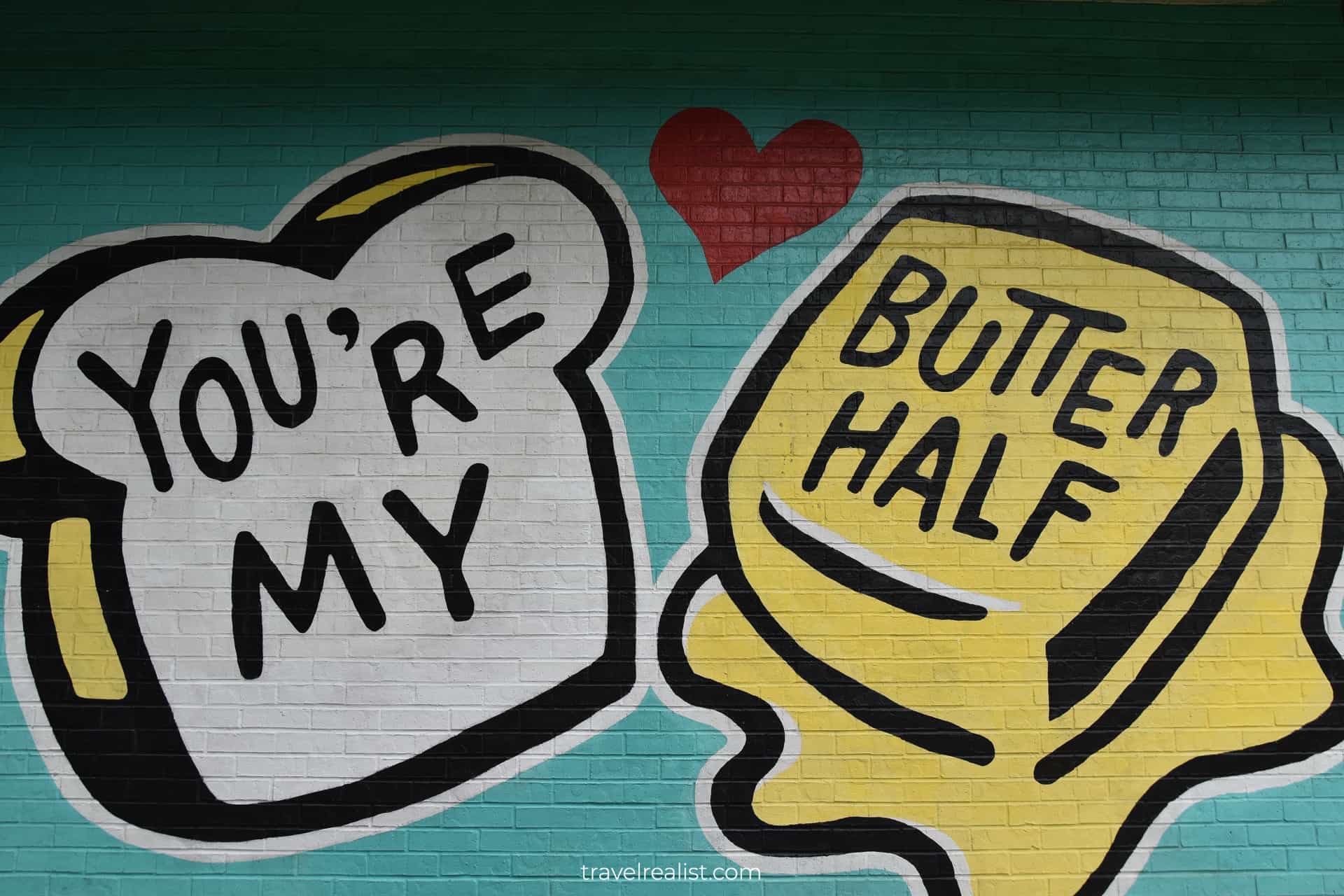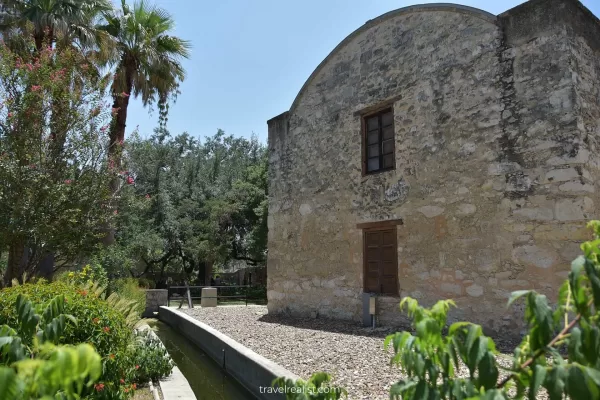Haas-Lilienthal House: Last Home Of the Victorian Era
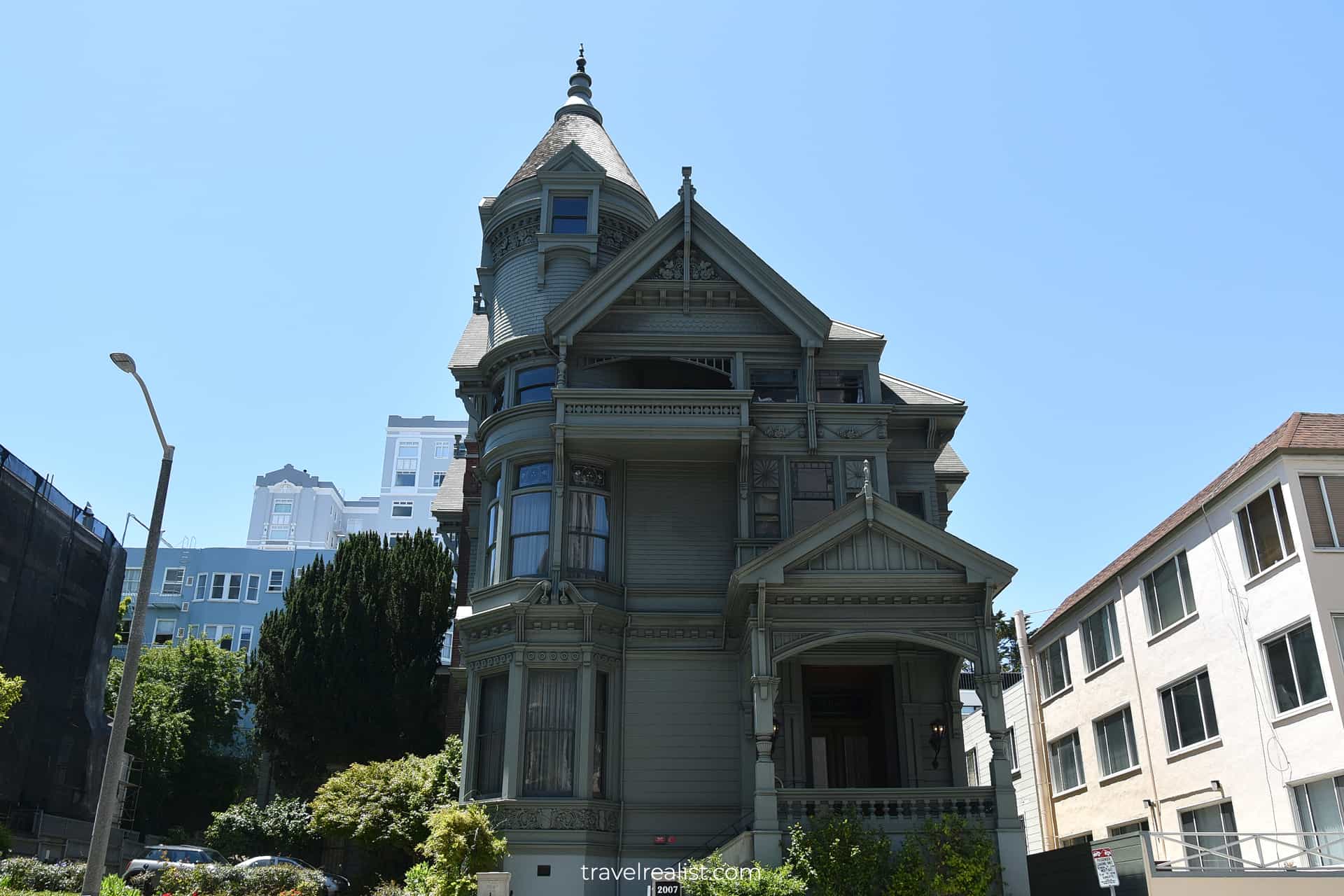
This realistic Haas-Lilienthal House Tour Review helps you plan your next visit to this architectural landmark.
The Haas-Lilienthal House in San Francisco dates back to 1886. Once one of many, the house is now the last intact Victorian era building in the entire city.
This post includes affiliate links that will earn us commission if you make a purchase via these links.
Sights & Places of Interest
The mansion and its grounds are the main attraction of the Haas-Lilienthal House. There is a lot to learn about the house and its owners.
The house carries the name of William Haas, an immigrant from Germany. Mr. Haas commissioned construction of this mansion in 1886.
The Haas-Lilienthal House is a survivor of the devastating 1906 San Francisco Earthquake and Fire. It became a museum in 1972 after a few generations of Haas and Lilienthal progenies.
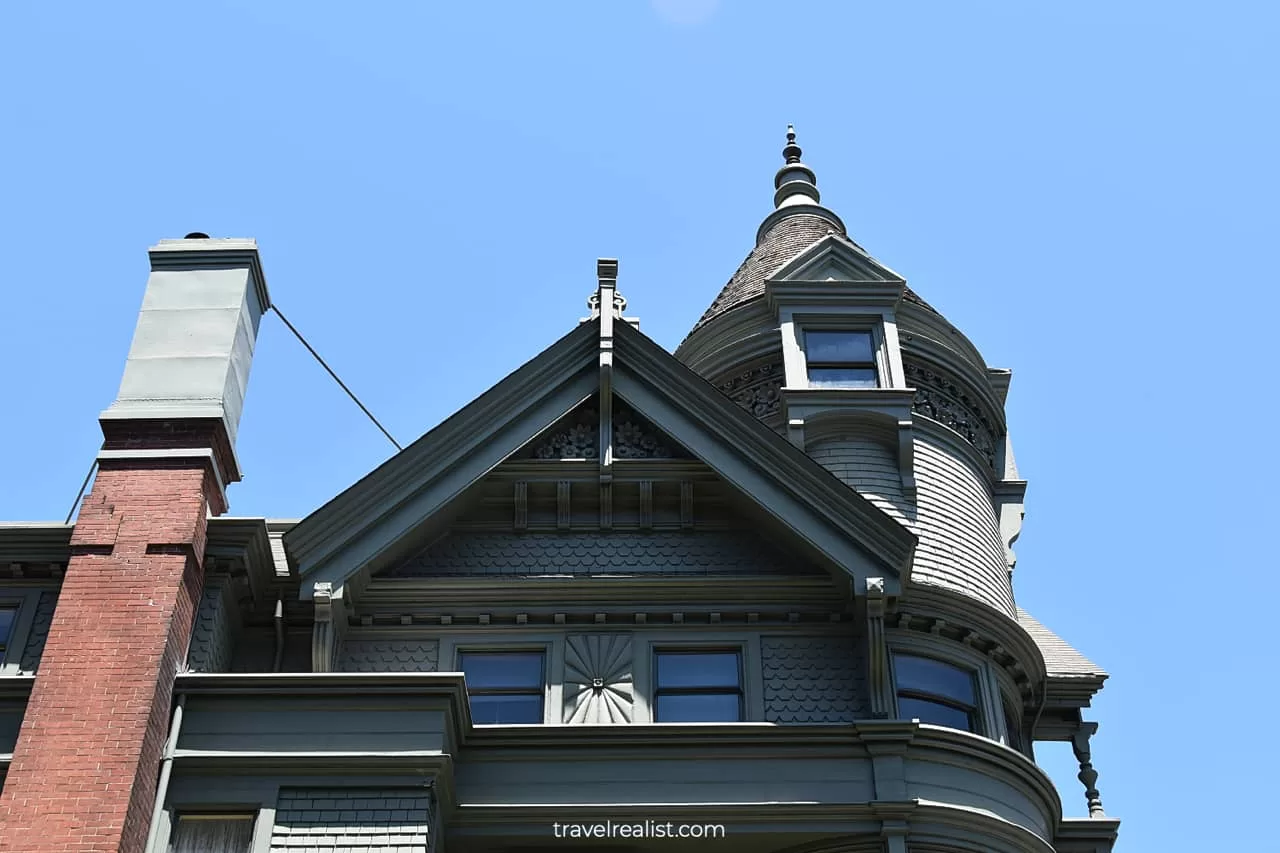
You could explore the house from the outside at your own pace. But you have to join a tour to admire its interior design. This Haas-Lilienthal House Tour Review follows a tour path through the mansion.
The house has a few entrances. The main entrance is facing the street. Since the mansion is on a hill, there is a staircase that leads to the main entryway.
Other entrances bring you to the garage and basement. The garage is not open to public. Instead, the house museum tours start in the basement from the right side passage.
As soon as you enter the basement, you will find yourself in a large ballroom. It now serves as a waiting room. This is where you could purchase a ticket for the next available tour.
There might already be a few people in the basement waiting for the tour to start. Yet, the group will likely be small. This is a bit surprising given the history and the condition of the Haas-Lilienthal House.
The house museums on the East Coast, like Gibson House Museum and Nichols House Museum, sell out. On the bright side, a smaller group makes it easier to learn about the house and take pictures.
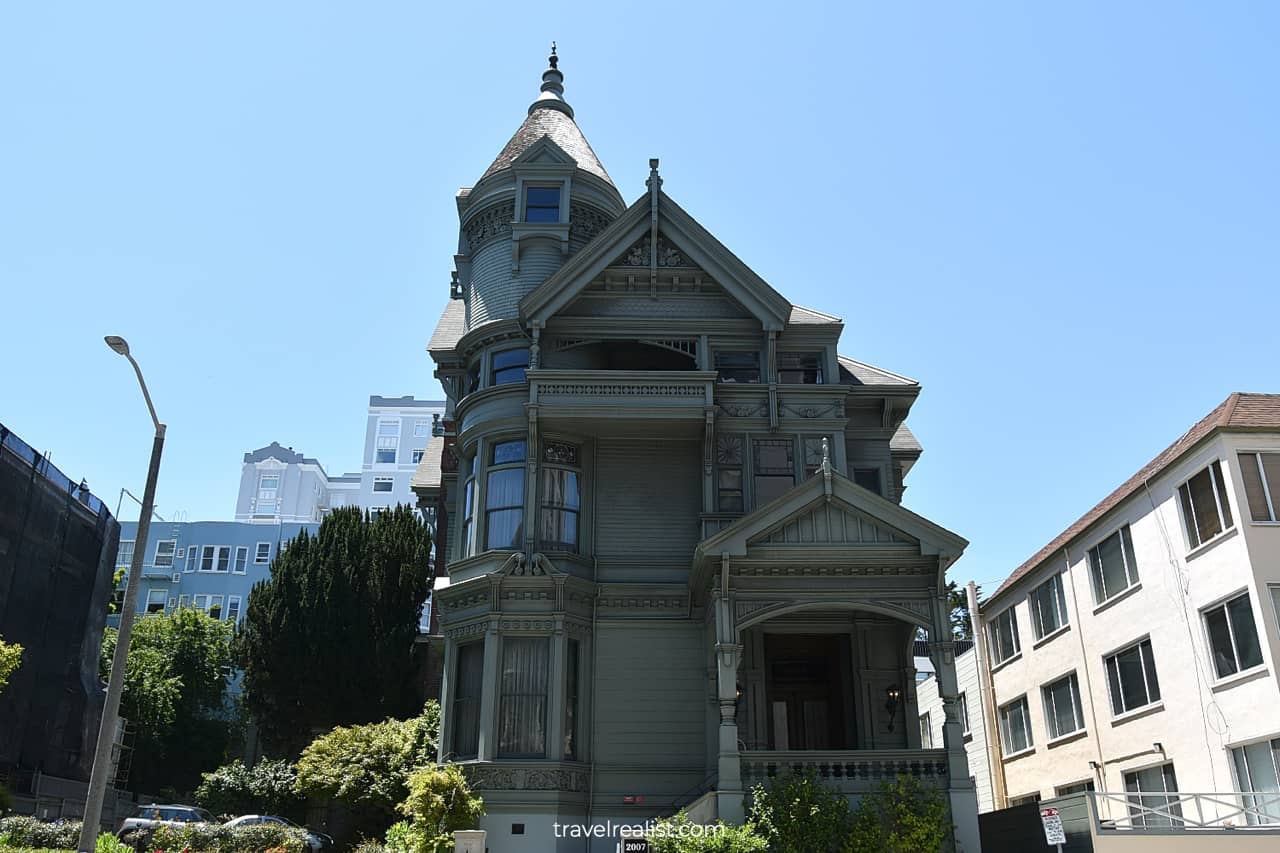
1. Outdoor Elements
You will go outside of the house as soon as the house tour begins. Your tour guide will bring you from the basement to the front yard. It is quite unusual compared to most other house museum tours.
On the one hand, you will get a closer look at the architectural elements of the house. The Haas-Lilienthal House is a perfect example of the Queen Anne – Eastlake style.
Unless you are into architecture or history, this might not tell you much. But your tour guide will point out the elements typical of this style.
You will spend 20 to 25 minutes of the tour time outside. You might wonder whether a guided walk outside of the house is worth a tour price.
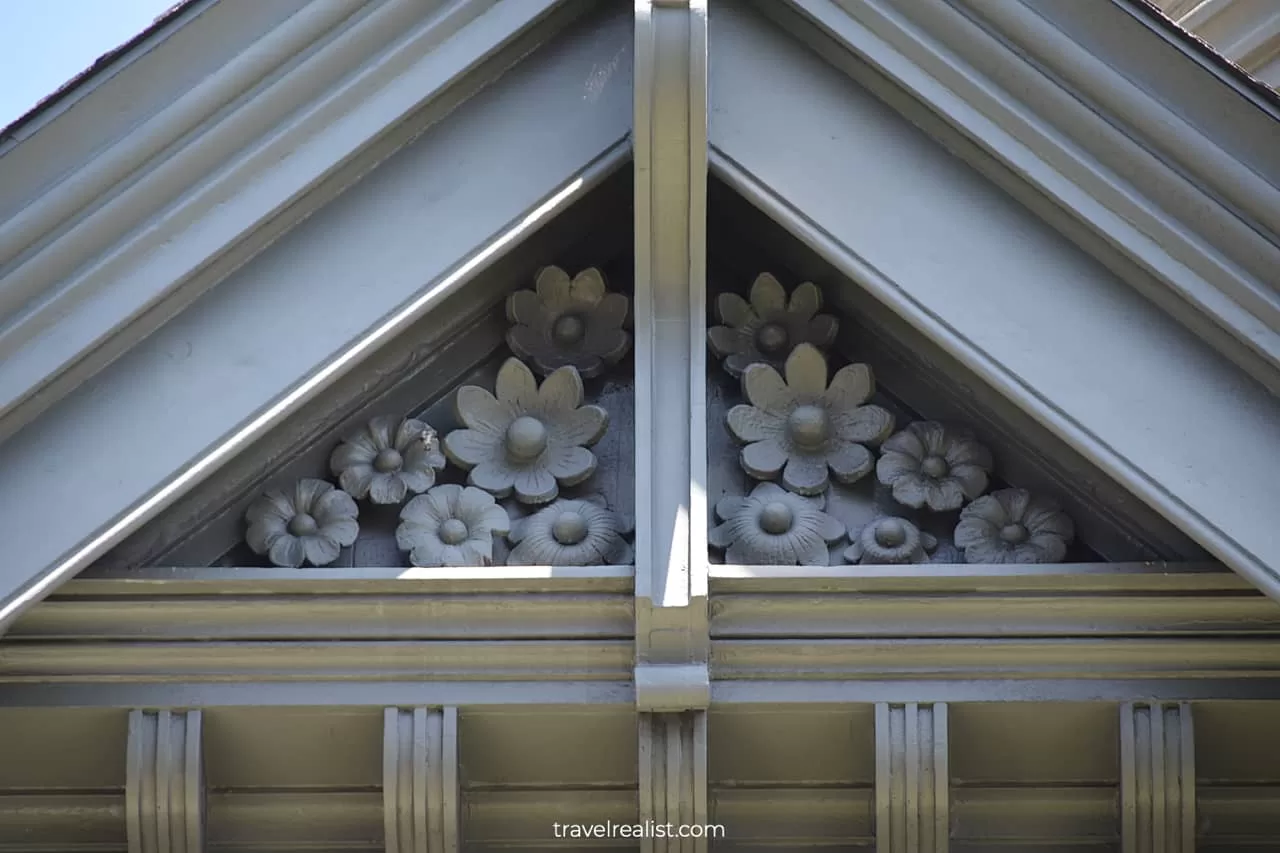
2. Hallway
Your doubts will disappear as soon as you enter the house through the main entrance. You will find yourself in a beautifully decorated hallway.
This room is in an excellent condition. It has a lot of interior design elements and items for you to explore. The tour guide will spend about 5 minutes in this room.
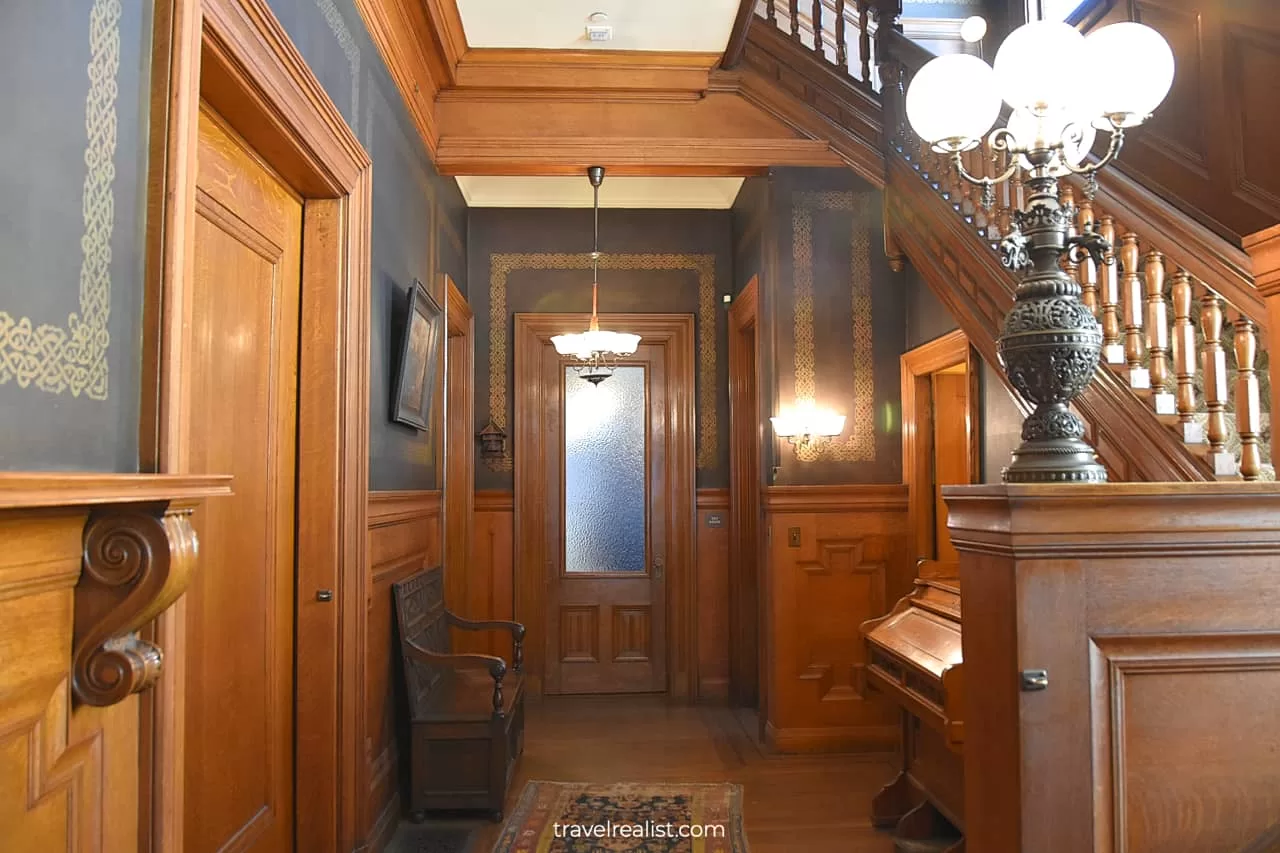
3. Grand Staircase
A grand staircase will likely be the first thing you notice in the hallway. The shape and craftsmanship of this staircase make it unique.
- The staircase starts at a 90-degree angle to the entrance.
- After a few steps, it turns left.
- The staircase continues straight for most of the way.
- It then takes another 90-degree turn to the second floor.
This staircase is a popular spot during wedding rentals of the house and photo shoots. It is easy to see its appeal.
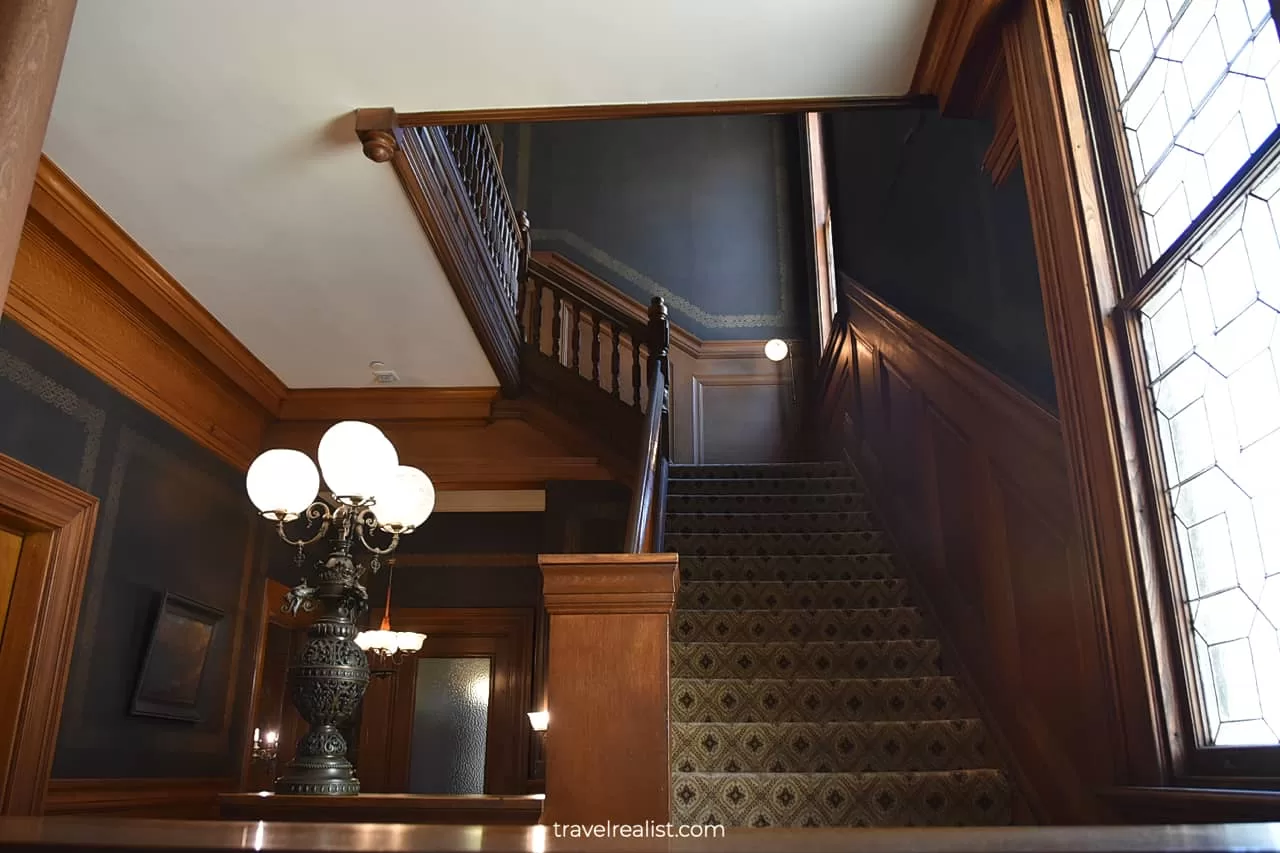
The entryway is home to other noteworthy items from the Victorian era. You should take a look at the floor standing grandfather clock. Its craftsmanship still shines through after many years.
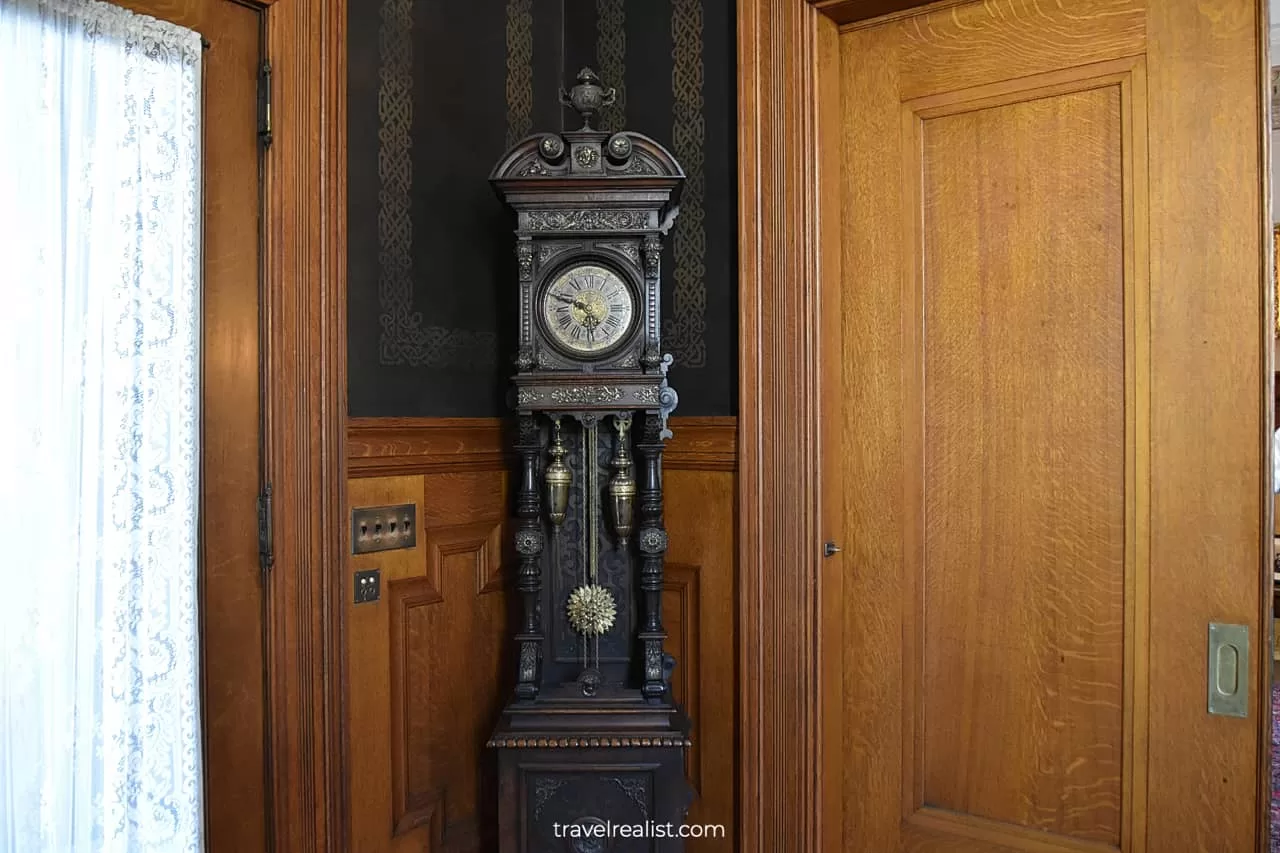
4. Parlors
The sliding door to the right of the clock reveals a parlor. A parlor is a different name for a living room. Like many living rooms of that period, this parlor has a sofa and a grand piano.
This room was a magnet for guests of the Haas-Lilienthal family a hundred years ago. The parlor still maintains its appeal to this day.
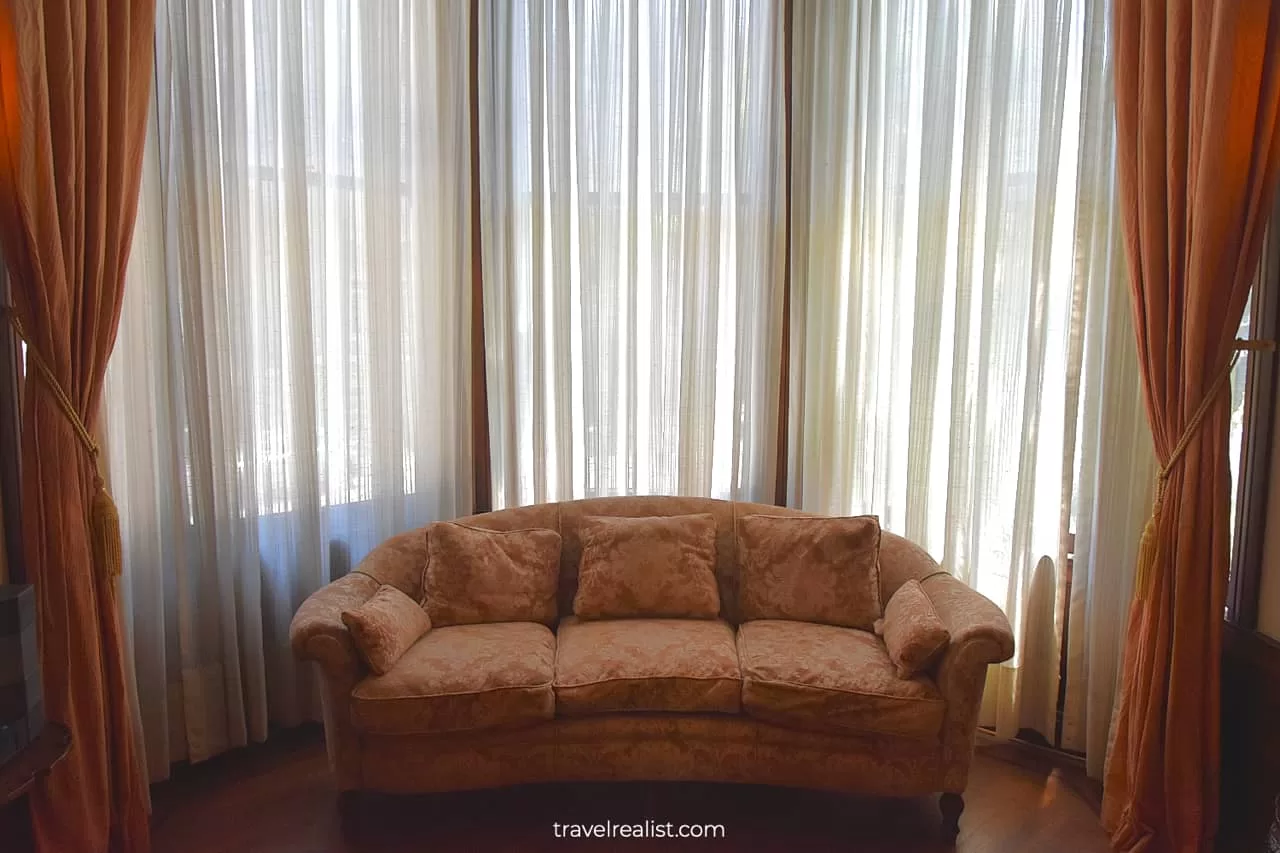
The Haas-Lilienthal House has two parlors on the ground floor right next to one another. This combination of parlors is quite unique to the house museums.
On top of it, all rooms on the first floor have beautiful sliding doors. These doors and panels are made of solid redwood.
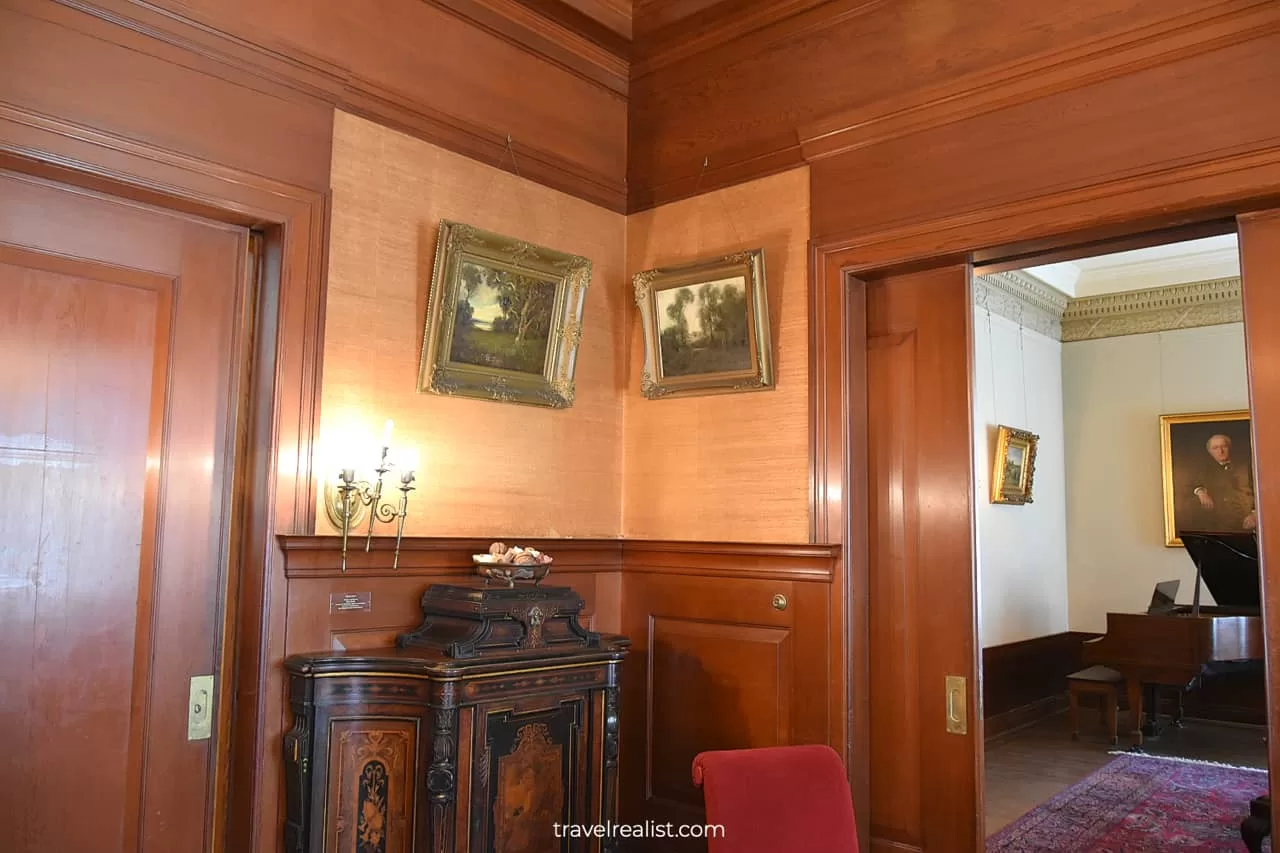
5. Dining Room
You will enter a dining room after a quick stop in the second parlor. The wooden elements are key to the design of this room.
There is a wooden kitchen set, dining table, fireplace frame, and wall panels. Black wallpaper covers the remaining parts of the wall. As a result, the dining room appears quite dark even during the day.
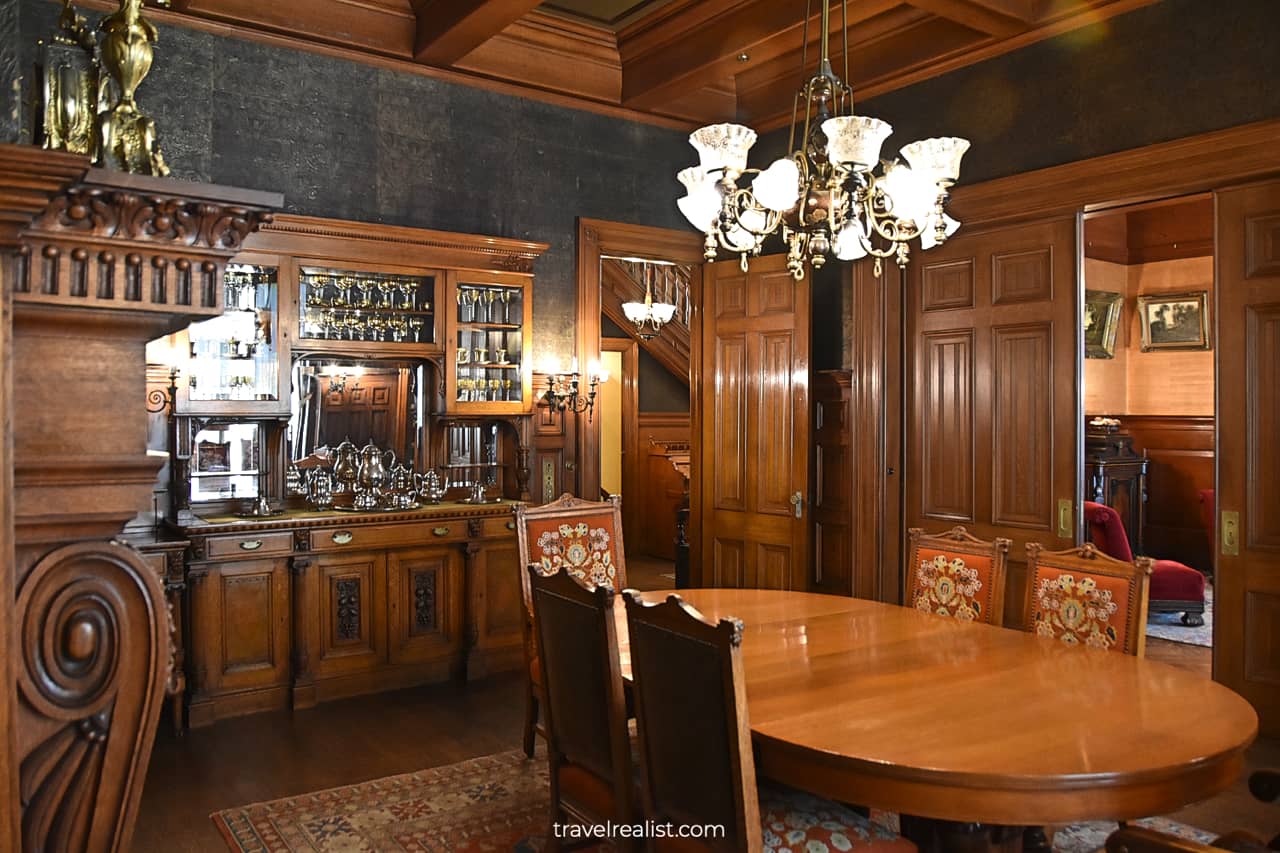
6. Kitchen
A kitchen is right next to the dining room. The house museums rarely preserve original kitchens. Most of them see little value in displaying the original appliances.
But the Haas-Lilienthal House is a notable exception from this rule. This house has a handful of historic kitchen items. You could take a close look at the oven, tee kettle, and pots.
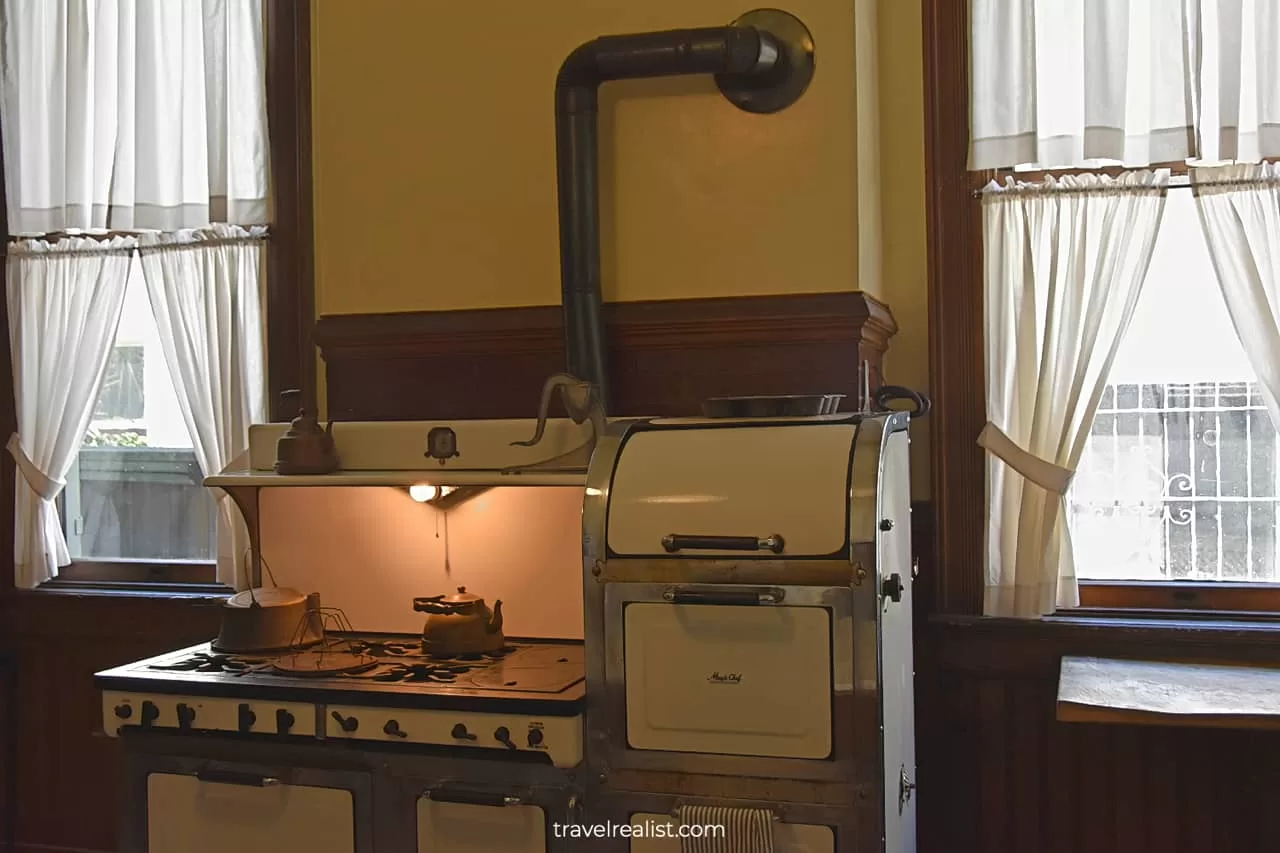
Your dining room and kitchen exploration will likely be brief. In the end, the tour guides have to make up for the long time discussing outdoor elements.
You will take the staircase to the second floor after a stop in the kitchen. This is your chance to get a different look at the grand staircase and hallway paintings.
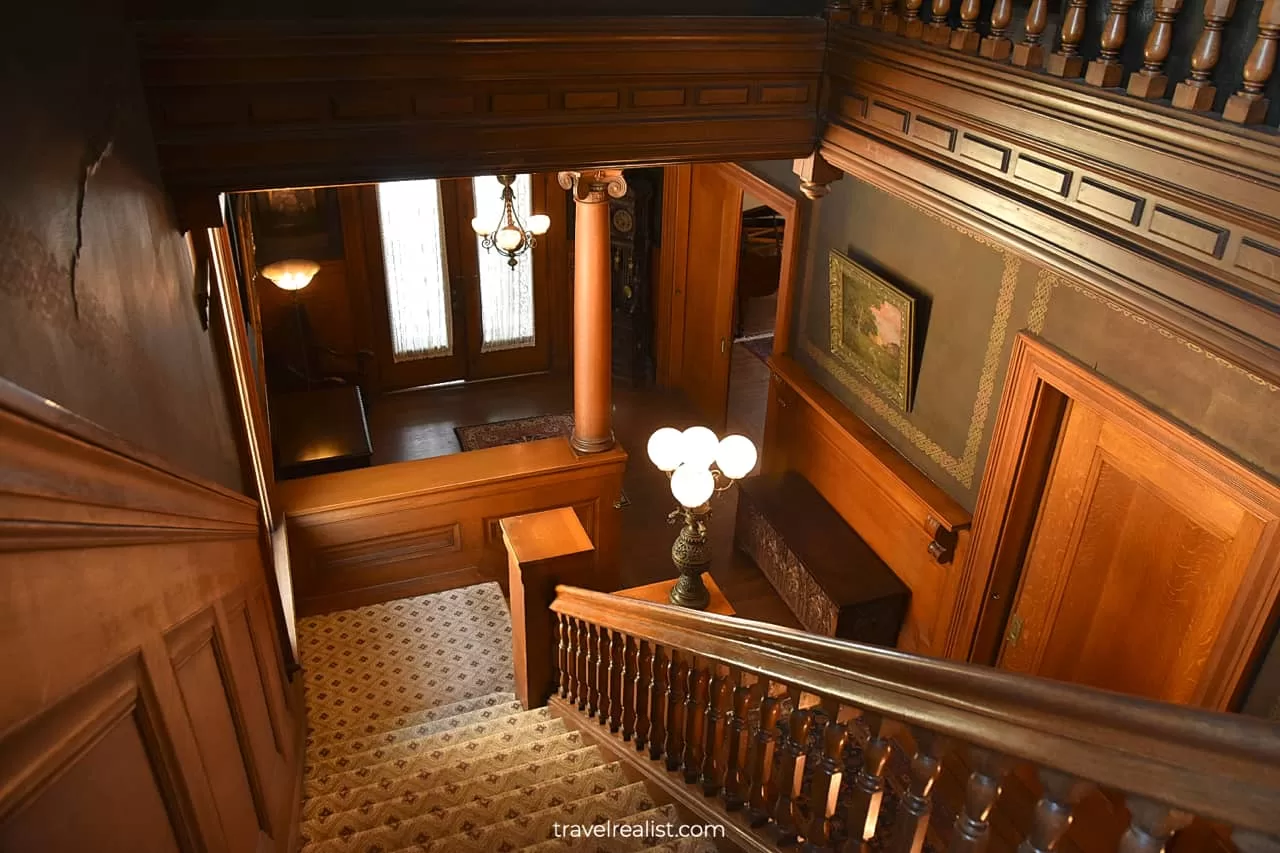
7. Library
A library is the most spacious room on the second floor. This room has a multiuse space. There are a few distinct areas that each serve a purpose.
The corner area has a bookcase and a fireplace. It kept the room warm during the chilly winters and evenings.
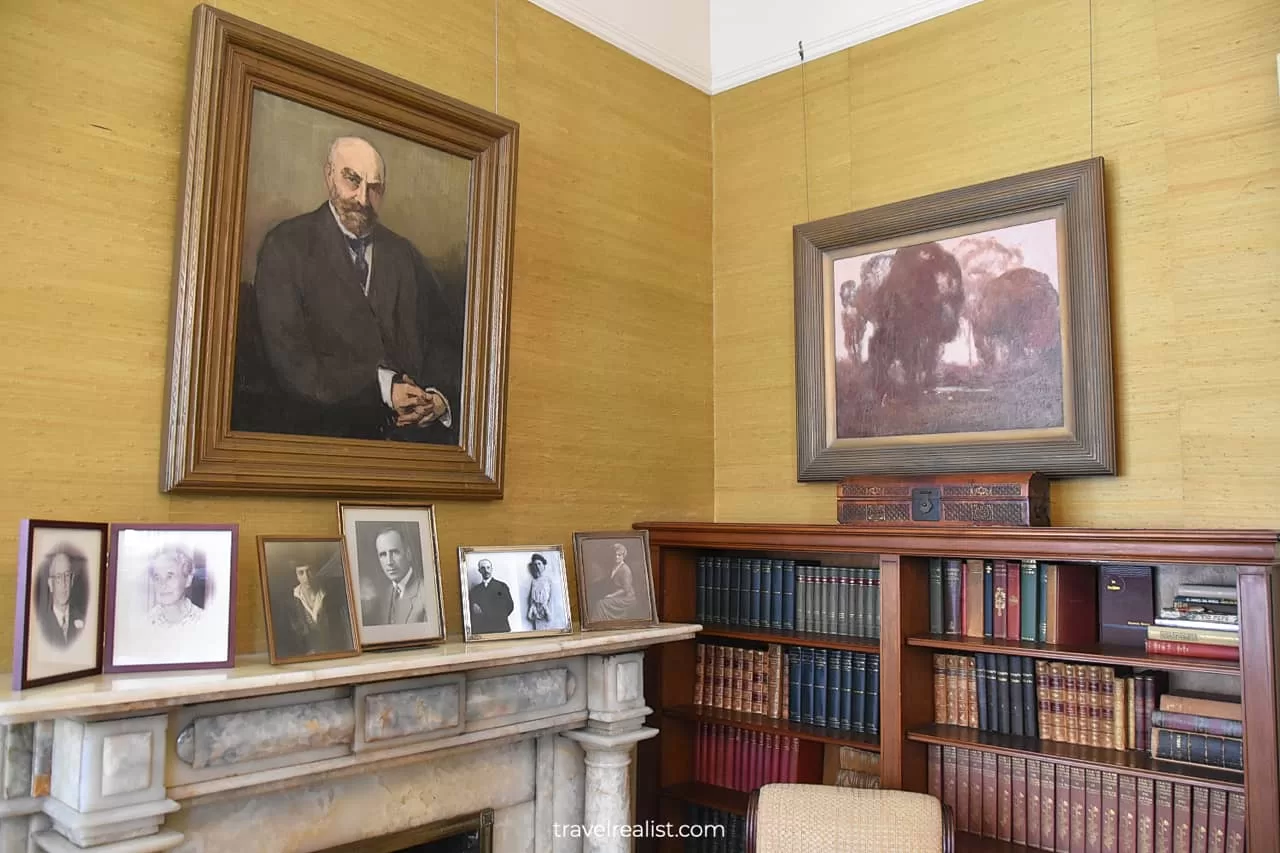
The left part of the library was likely a study. There is a desk and a few bookcases with countless books. This was a great spot to read to a book in solitude.
One or two books, like the the Webster’s New International Dictionary, will be on display. It is possible that museum staff exchanges the book on display from time to time.
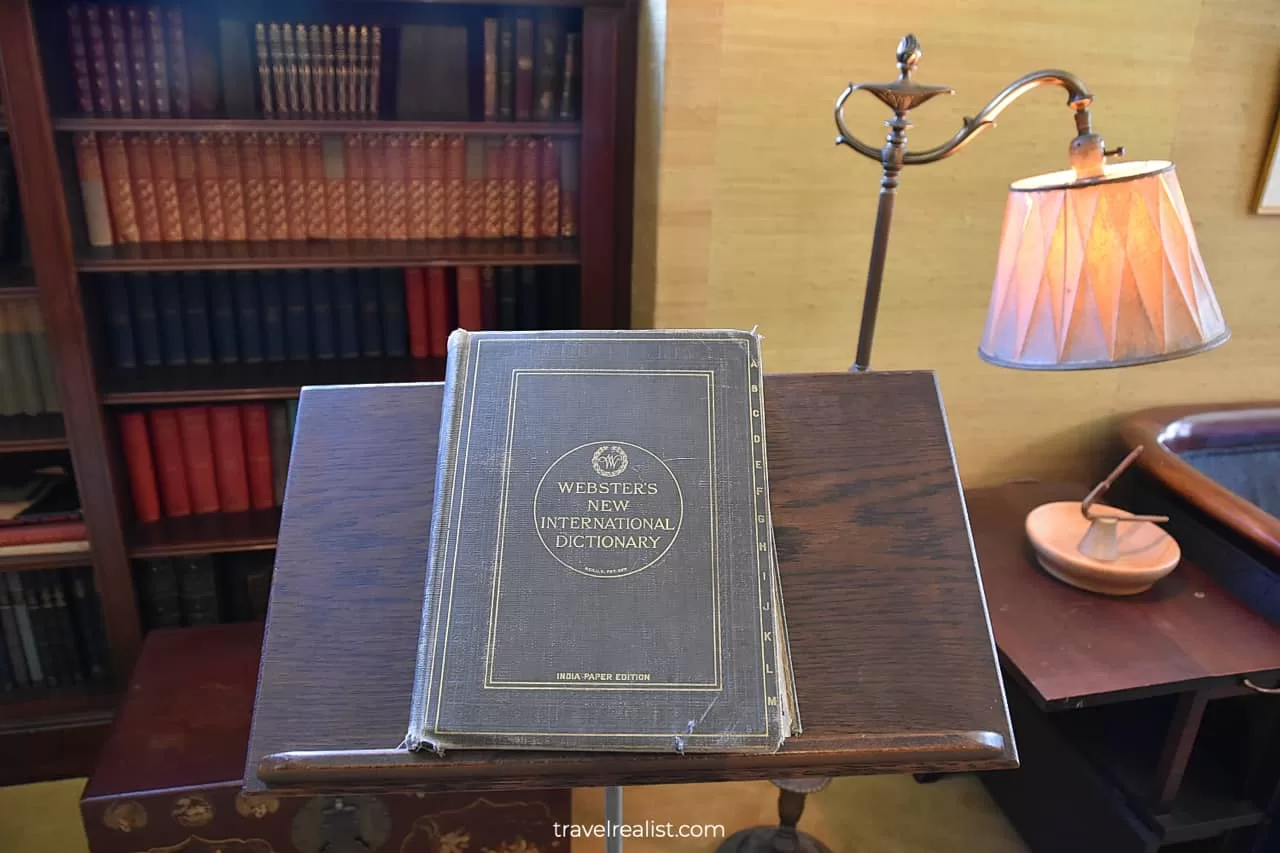
The central area of the room has a futon and an armchair. There are also beautiful floor and table lamps. This part of the library might have served as a third parlor back in the day.
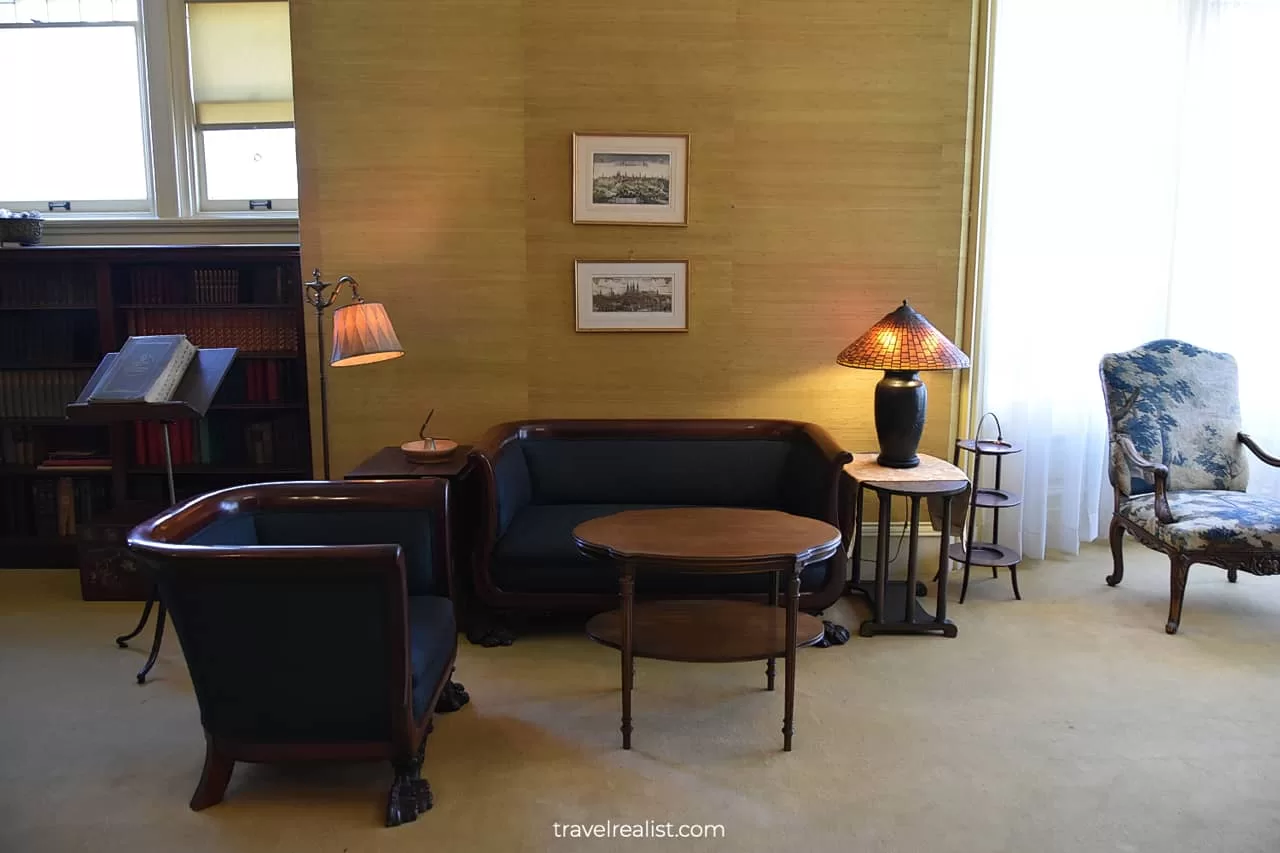
There is one last area of this room that deserves your attention. Two comfortable chairs and a coffee table are right next to the panoramic windows.
It is easy to imagine how conversations were flowing in this room back in the day. The lamp on the coffee table belongs to a later period. But it fits right in.
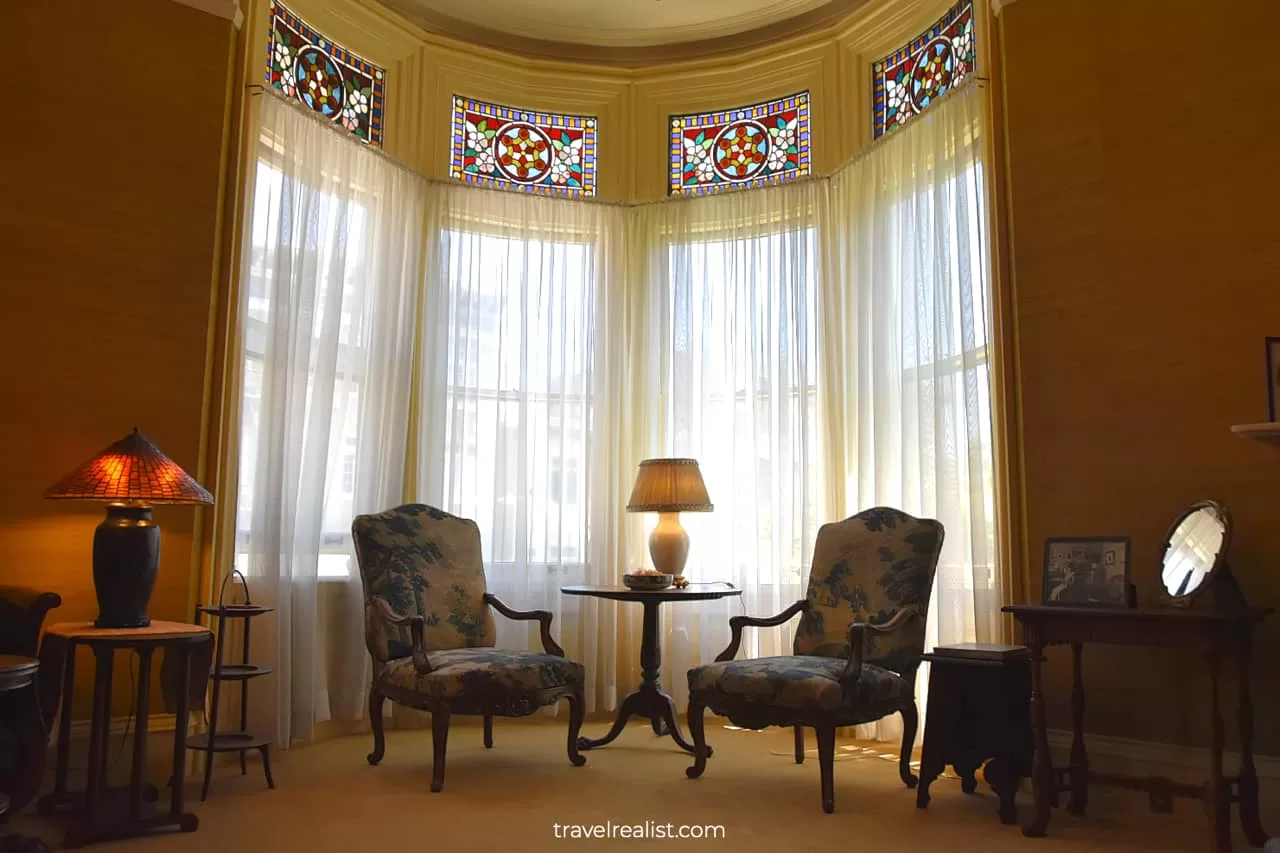
You might not be able to take your sight from the beautiful stained glass panels. This window panels are a true masterpiece. But not everyone felt that way.
According to the tour guide, the house late owners despised these panels. They even covered them from the inside. The museum staff uncovered these remarkable window elements during the restoration.
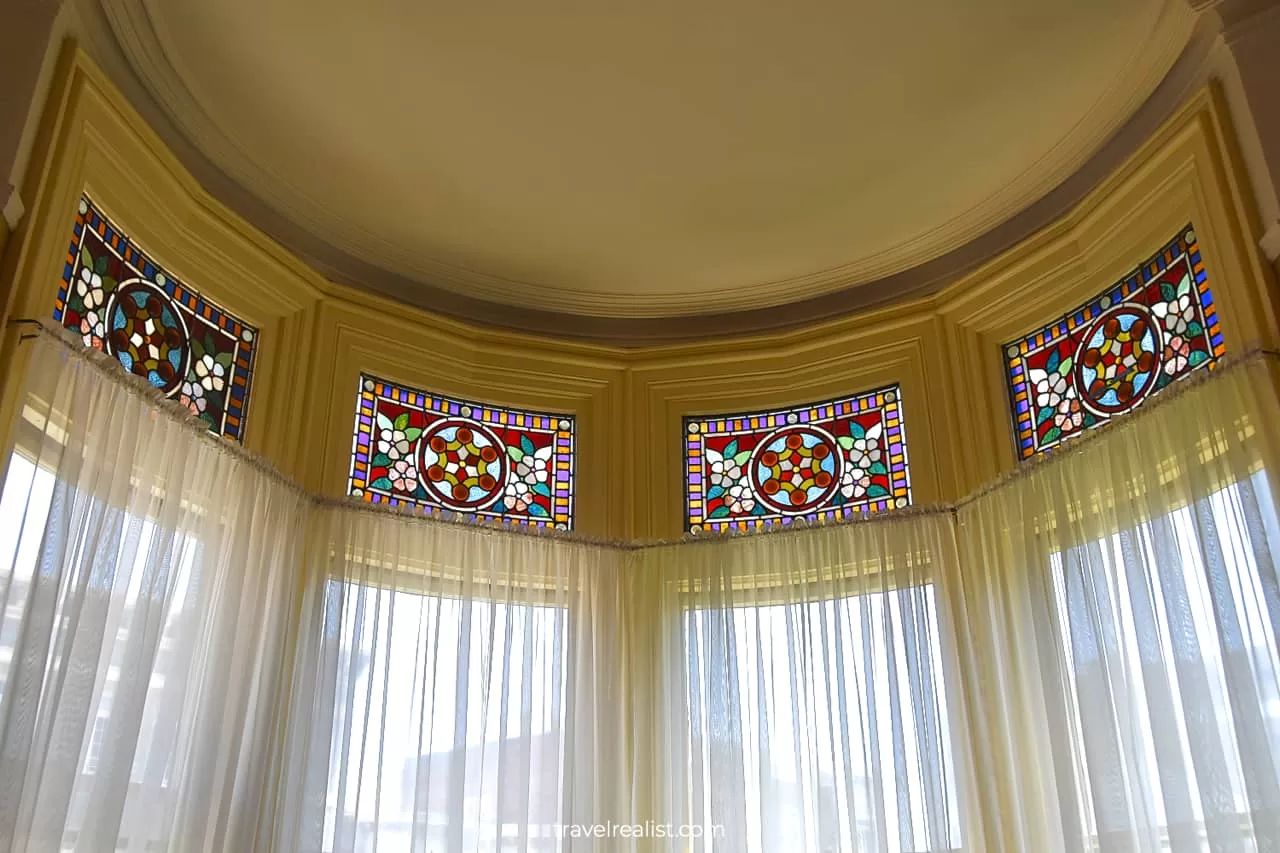
8. Master Bedroom
You will see similar stained glass windows in the nearby master bedroom. These panels are a real highlight of the second floor of the Haas-Lilienthal House.
The master bedroom has a bed set and furniture from the Victorian era. There are also countless photographs and items that belonged to the owners.
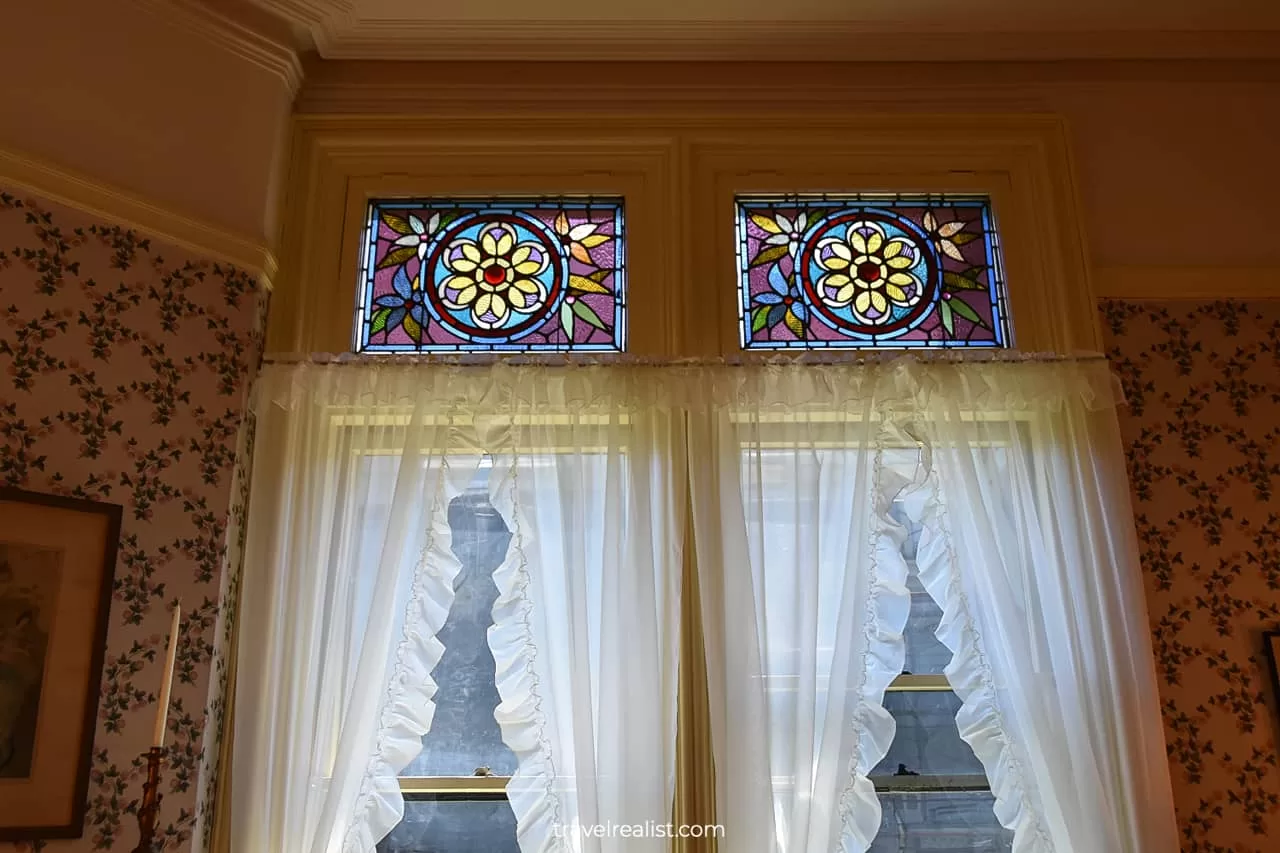
9. Bathroom
The master bedroom connects to the bathroom. The design of this room could remind you of many mansions throughout the United States. There are also a handful of historic items in this well-lit room.
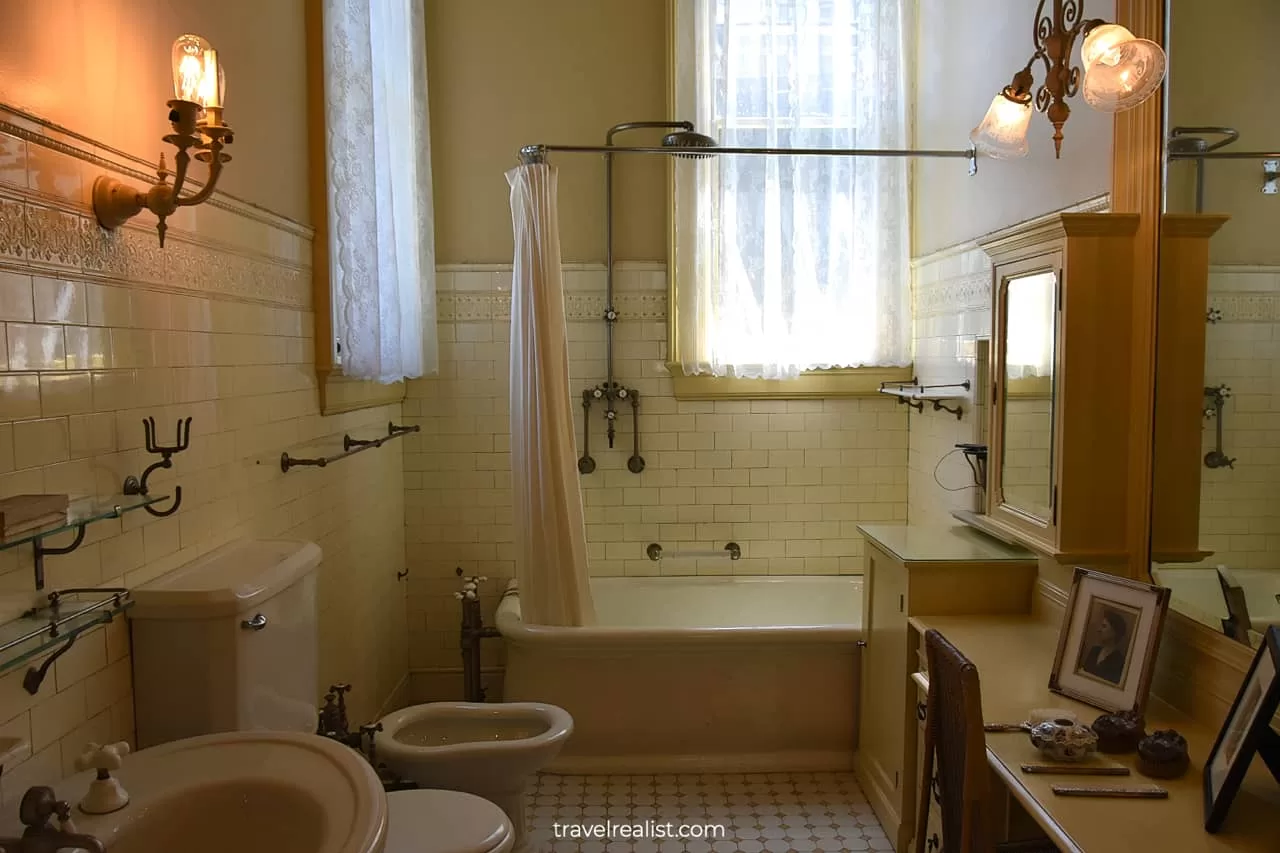
10. Nursery
The bathroom is one of the last rooms in the house that displays historic furniture. Other rooms on the second floor have museum exhibits.
At least, the nursery has a doll house and toys from the Victorian times. The other former bedroom in the Haas-Lilienthal House has even fewer historic items.
Instead, it is full of wedding photos. All of them display the celebrations that took place in this house museum over the years.
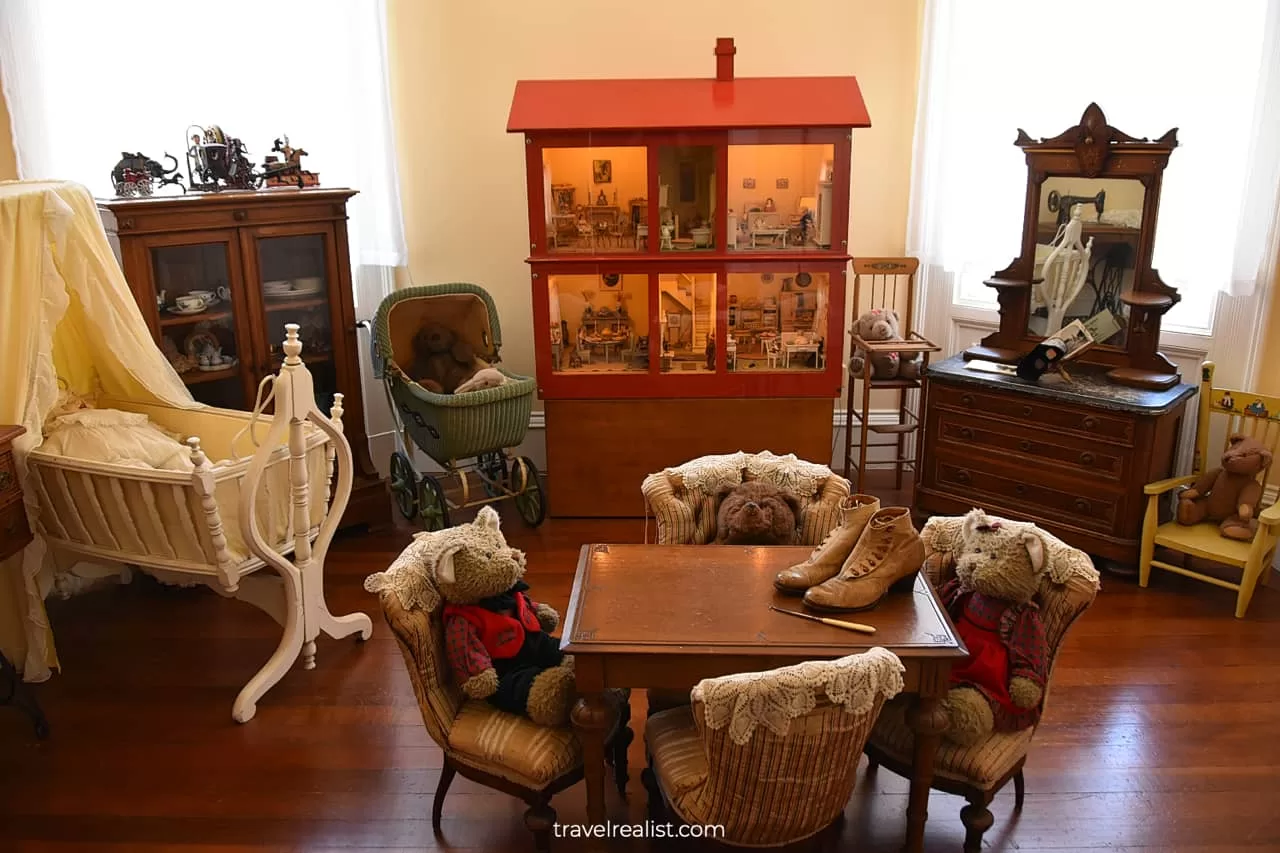
11. Basement
The Haas-Lilienthal House tour comes to an end in the basement, the same place where it starts. But there is one more thing to see before you part ways with your tour guide and fellow visitors.
The basement is home to a miniature railway. Just like the doll house in the nursery, it dates back to the Victorian era. The museum staff continues restoring the railway for future visitors.
You should take a closer look at the miniature trains and cars. The craftsmanship of the restorers is yet again on full display in this house museum.
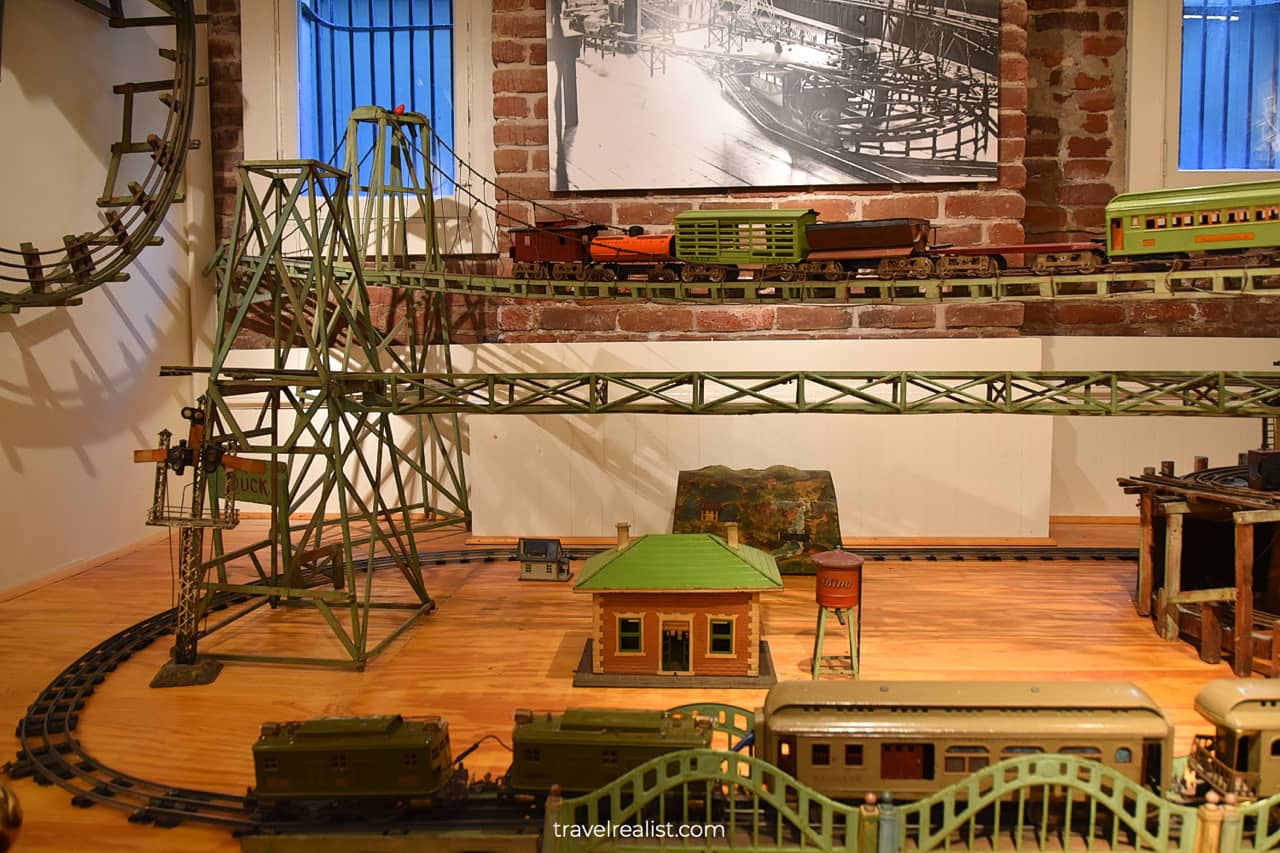
You will finish your house exploration a few minutes past the hour. There are a handful of other rooms in the Haas-Lilienthal House. But they are not open to public.
- A few of these rooms are in the basement, next to the miniature railroad and ballroom.
- The entire third floor houses museum offices.
Continue with this Haas-Lilienthal House Tour Review. You will learn more about ways to get to the sights, entrance requirements, and places to stay.
Getting to Haas-Lilienthal House
The Haas-Lilienthal House is at 2007 Franklin Street in San Francisco, California. The house is in Pacific Heights neighborhood. It is a block west from Van Ness Avenue.
You can reach the house museum in a few ways.
- You could drive a car to the house but you might run into parking issues.
- There is no visitor parking at the Haas-Lilienthal House.
- You would need to search for street parking or park at a nearby paid garage.
- You could reach the Haas-Lilienthal House via public transport.
- A few bus lines stop near the house.
- The house is five blocks away from both California Street and Powell / Hyde Cable Cars.
Where to Stay in San Francisco
The Haas-Lilienthal House is in the heart of San Francisco. But the location of this house museum is a two-edged sword.
- On the one hand, there are plenty of places to stay within a walking distance from the museum.
- On the other hand, most of them charge exorbitant rates. But you might get a good deal if you book in advance.
You could also bring the lodging cost down if you take public transport. Taking Muni (bus, streetcar, cablecar), BART (rapid transit), or Amtrak (train) is a great way to save on a hotel.
This way, you could broaden your search for a place to stay. In this case, you might want to look for places to stay near train stations or bus stops.
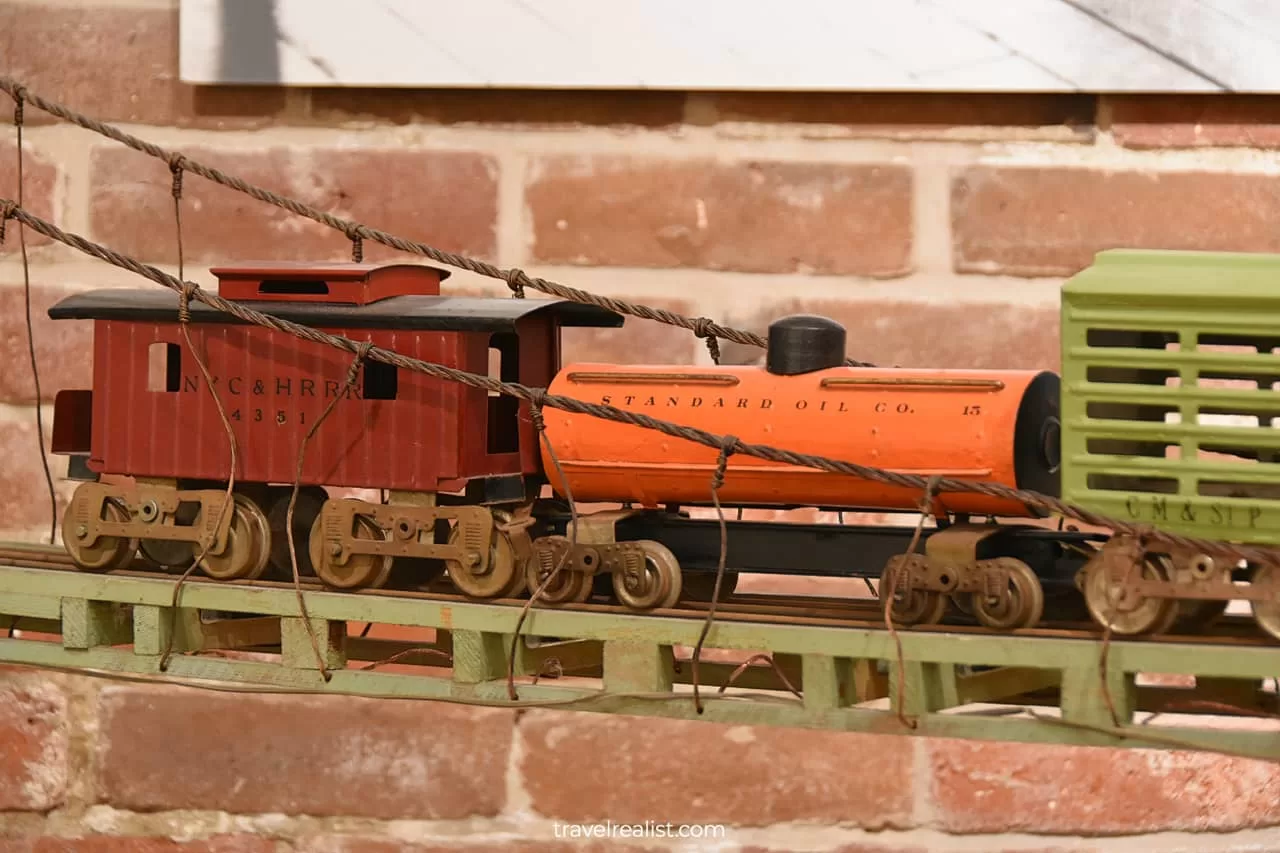
Entrance Requirements & Passes
The Haas-Lilienthal House is only open to guided tours. You can take a tour on weekends or on the 2nd and 4th Wednesday of each month. The house is closed on all major holidays.
There are a few tour options: house, private, and walking tours, and house rentals.
- House tour
- The tour runs on weekends and select Wednesdays at 12 p.m., 1 p.m., and 2 p.m.
- Each tour takes about an hour.
- It costs $10 for adults. Seniors pay $8 per person. Children under 12 and members visit free.
- You cannot buy the house tour tickets in advance.
- Private tour
- It runs on the same days as the house tours.
- A private tour costs $150+ and depends on the size of your group.
- You need to book the private tour in advance.
- Walking tours
- This tour is available on most Sundays.
- It is free.
- This tour is a way to learn about the neighborhood history rather than the house.
- House Rental
- You could rent the Haas-Lilienthal House for a reception or a wedding.
- You can find the prices on the museum’s website.
- It is key to arrange the rental well in advance.
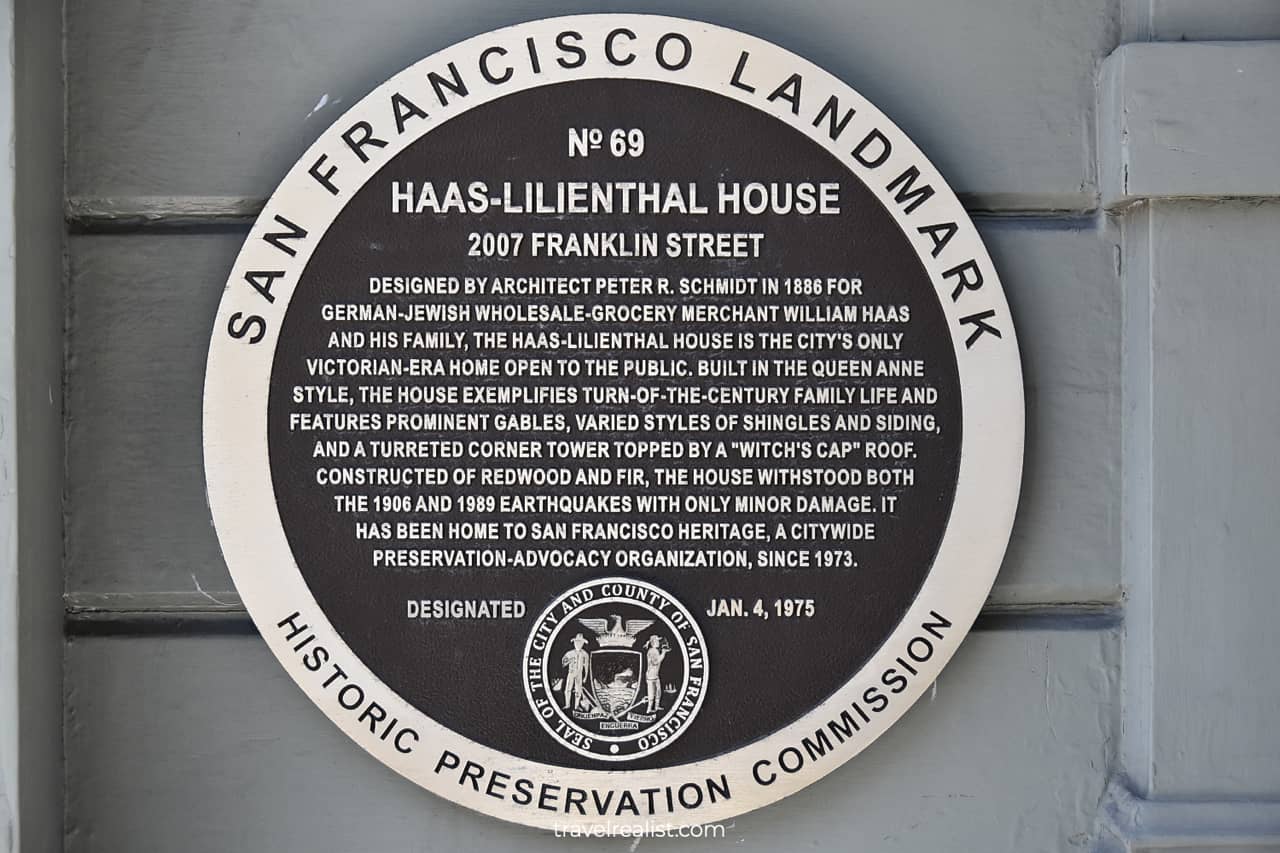
Takeaways: Haas-Lilienthal House
The Haas-Lilienthal House is a picturesque house museum in San Francisco, California.
- The architectural style and interior design of this house will appeal to the architecture lovers. Its items will send you back in time.
- The tour is quite affordable. Compared to the Winchester Mystery House, the Haas-Lilienthal House admission is a steal at $10.
But there are a couple of drawbacks when visiting this house.
- You cannot buy tour tickets online. If a tour sells out, you might have to wait for the next one or postpone your visit.
- The tour focuses a little too much on the outside of the house. As a result, the room exploration might feel rushed once you get inside.
You would need to decide for yourself if the pros of a visit outweigh the cons. Who knows, you might get a better experience. In this case, the Haas-Lilienthal House is one of the best sights in San Francisco.
You cannot shoot videos in the house. Therefore, there is no Haas-Lilienthal House Video Tour Review. Visit the YouTube channel for the latest videos about other sights.
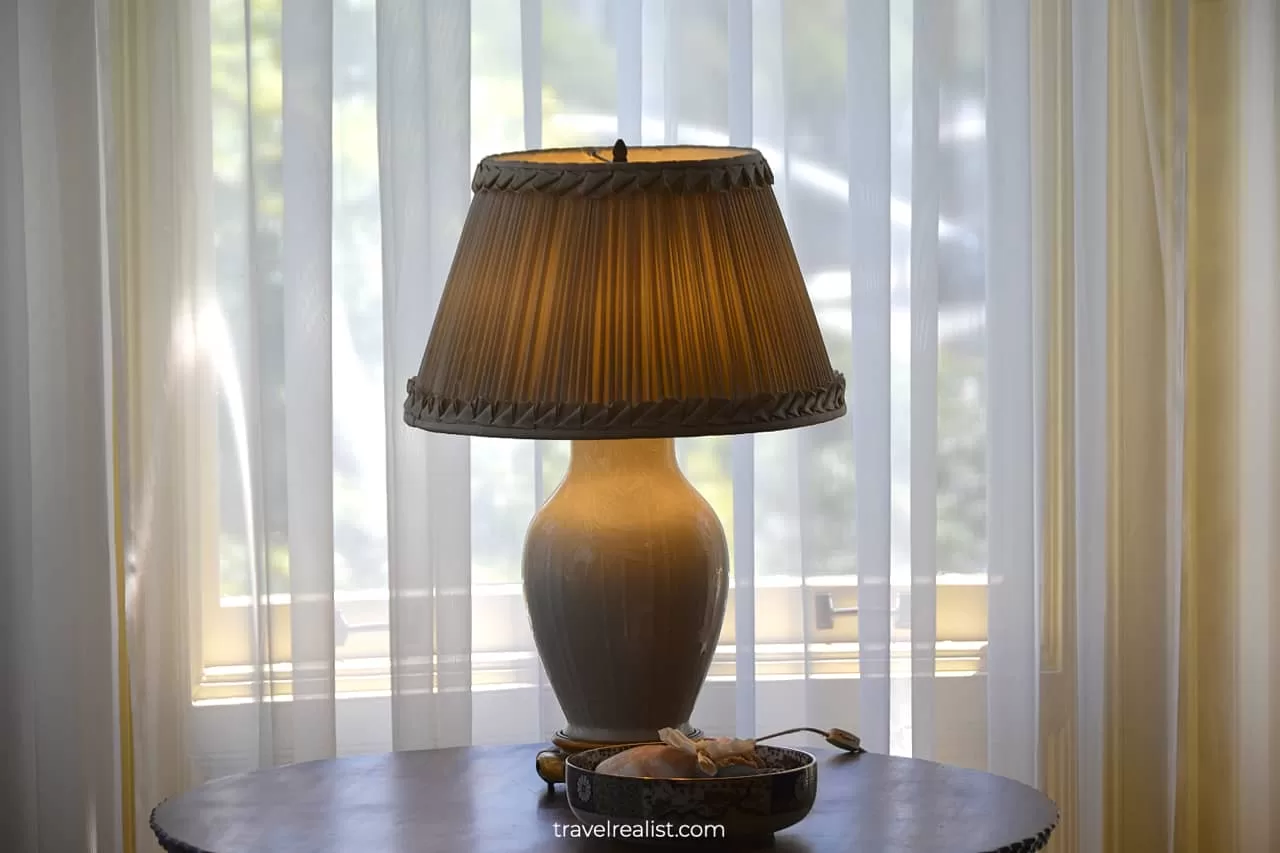
Frequently Asked Questions
The Haas-Lilienthal House is open for tours on the 2nd and 4th Wednesdays and most Saturdays and Sundays. The house tours run at 12pm, 1pm, and 2pm.
You can take a guided house tour, a private tour, or rent the house for a reception or a wedding.
You cannot buy Haas-Lilienthal House tour tickets in advance unless you book a private tour.
The Haas-Lilienthal House tour costs $10 per adult or $8 per senior. Children under 12 and museum members get free admission.
The Haas-Lilienthal house was built in 1886.
The Haas-Lilienthal House survived the devastating 1906 San Francisco fire and earthquake. It is the only intact house of the Victorian era in San Francisco.
The Haas-Lilienthal House tour takes about an hour. A third of the tour takes place outside of the house. The rest of the tour explores the rooms on the three floors of the mansion.
The Haas-Lilienthal House is in Pacific Heights neighborhood of San Francisco. There are a lot of places to stay within a short walk from the house museum.
Take public transport to expand your search to other areas of San Francisco. This way, you could find a better deal and visit other sights of the city.
The Haas-Lilienthal House is a beautiful house museum. You will not be disappointed if you enjoy history and architecture. Interior exploration might feel a bit rushed but your experience may vary.
Safe realist travels!

